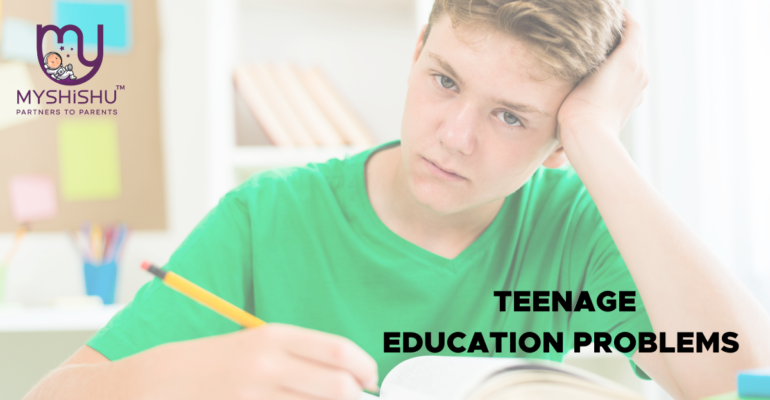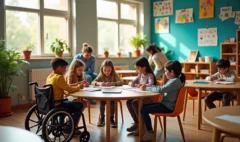Addressing the Challenges: Teenage Education Problems in the Modern World
Addressing the Challenges: Teenage Education Problems in the Modern World
The educational landscape is constantly changing, and the challenges youth face in the classroom today are very different from those of previous generations. As technology makes more products and tools available, it brings new distractions and complexities. This blog explores some of the major challenges facing teens in today’s education, explores possible solutions, and recommends a holistic approach to learning.
Table of Contents
The constant challenge: Academic pressure
- Standardized testing: The pressure to perform well on standardized tests can cause a lot of stress in adolescents. These tests tend to emphasize memorization rather than critical thinking and actual application of knowledge.
- College application rat race: Competition for top universities has intensified. Adolescents feel pressure to excel not only academically, but also in extracurricular activities, sports, and community service.
- Changing job market: The skills needed to succeed in the workforce are constantly changing. Traditional education systems may not adequately prepare young people for the jobs of tomorrow.
Attractions in the digital age:
- Short attention spans: In the digital age, a constant stream of information and stimuli can lead to short attention spans. Teens may struggle to learn deeply and focus on complex ideas.
- Social media addiction: Social media platforms are designed to make teens neglect their studies and spend more time scrolling through feeds.
- Cyberbullying and cyberbullying: The anonymity of the internet emboldens bullies. Cyberbullying can be relentless and can have a significant impact on a teenager’s psychological well-being and learning.
Importance of relevance and engagement:
- Curriculum disengagement: Some youth find the traditional curriculum irrelevant to their interests or future goals. Disengaged students are less likely to retain information or be motivated to learn.
- Passive vs. passive learning. active learning: Traditional, teacher-centered classrooms can be passive learning. Young people crave more hands-on, dynamic experiences that allow them to apply knowledge and develop critical thinking skills.
- Focus on memorization versus problem solving: The emphasis on memorizing facts for practice may not translate well into real-world problem solving skills needed for future success.
Dealing with the challenges: A multi-pronged approach – disconnect
This section outlines a multi-dimensional approach to the challenges faced by young people in today’s educational environment. Let’s go into each case in detail:
1. Rethinking the idea of a standardized test:
- Focus on skill development: Traditionally, standardized tests focus on memorizing and rewriting facts. This approach does not reflect a student’s ability to think critically, solve problems, or communicate effectively. Instead, tests should be developed to assess these critical skills that are important for success in college and beyond.
- Multiple measures: Relying solely on standardized tests can lead to a narrow view of student achievement. The holistic approach includes research options such as portfolios, projects, and presentations. This type of assessment allows students to express their learning differently and their understanding more broadly.

2. Redefining college readiness:
• Focus on Life Skills: Educational programs are often designed to prepare students for standardized tests and college exams. However, many of the skills needed to succeed in college and the workforce are underserved. These “life skills” include:
o Critical thinking: the ability to analyze information, analyze arguments, and draw independent conclusions.
o Effective Communication: Ability to express ideas clearly and concisely orally and in writing.
o Collaboration: Ability to work well with others in a team setting.
o Adaptability: The ability to adapt to new situations and learn new skills quickly.
By equipping young people with these important life skills, they will be better prepared for the challenges of higher education and the ever-changing job market.
• Looking for a job: Many young people graduate from school without knowing their career path. Integrating career exploration into the curriculum can help them understand career options and skills needed for their jobs Through career counseling, workshops, or job shadowing opportunities, youth can gain insight valuable and have chosen their future more informed .
3. Take advantage of technology, not fight it:
- Technology integration: Technology can be a powerful learning tool when used properly. Educational apps, simulations, and online resources can cater to different learning styles and make classes more engaging. Interactive concepts can bring abstract ideas to life, while educational apps can provide personalized learning experiences.
- Digital citizen: The digital world presents its own challenges. Teaching young people about digital literacy, online safety and responsible use of social media is important. This includes educating them on issues such as cyberbullying, online privacy and responsible sharing of information. By promoting digital citizenship, we can help young people become responsible and safe users of technology.
4. For participation and eligibility:
- Individualized learning: A “one-size-fits-all” approach to learning doesn’t work for everyone. Individualized learning caters to students’ individual needs and interests. This could be:
o Project-based learning: Students work on projects that allow them to apply their skills to real-world problems.
o Differentiating Instruction: Teachers tailor their instructional strategies to the different learning styles and abilities in the classroom.
o Student Choice: Students have a say in the topics they explore or the projects they work on, creating a sense of ownership and involvement in their own learning.
- Real-world application: Integrating learning concepts with real-world situations can make learning more meaningful and interesting. This could be:
o Problem Solving Activity: Students work together to solve real problems that require application of what they have learned.
o Internships: Gaining practical experience in a professional setting can provide valuable insight into possible career paths.
o Service Learning: Volunteering in the community enables youth to connect their learning to social issues and develop empathy and civic responsibility.
• Social-Emotional Learning (SEL): Academic success is not just about grades. SEL programs aim to develop emotional intelligence, communication skills, and appropriate coping strategies. Learning how to manage emotions, build relationships, and resolve conflict are essential skills for success in all areas of life. Integrating SEL into the curriculum can help adolescents deal with adolescent challenges and succeed academically and personally.
Role of parents, teachers, and community
parents:
- Engage: Show interest in the teen’s education, participate in school activities, and communicate regularly with teachers.
- Create a supportive environment: Provide a conducive environment for learning and encourage open communication about learning difficulties.
- Set technology boundaries: Establish appropriate screen time and encourage positive behaviors around technology use.
Teachers:
- Embrace innovation: Integrate new teaching strategies that are technologically sensitive and address different learning styles.
- Focus on skill development: Go beyond memorization and prioritize the development of critical thinking and problem-solving skills.
- Create a safe and inclusive environment: Create an environment where students feel comfortable seeking help and support in dealing with mental wellbeing.
community:
- Support schools: Recommend appropriate funding for schools and investment in programs to address the specific needs of youth.
- Promote mentoring programs: Mentoring programs can connect youth with experienced professionals and provide valuable guidance.
- Promote mental health awareness: Work to de-stigmatize mental health issues and promote resources available in the community.
Additional Common Questions
Q: Are standardized tests a good measure of student progress?
A: Standardized tests can be useful tools, but they cannot be the only measure of student achievement. These tests tend to focus on memorization and do not necessarily assess important skills such as critical thinking, problem solving and communication.
Q: What are “life skills” and why are they important?
A: Life skills are among the most important abilities necessary for success in college, work, and personal life. These include critical thinking, communication, collaboration, and flexibility. Educational programs need to equip young people with these skills to prepare them for a changing world.
Q: How can technology be best used in education?
A: Educational apps, simulations, and online resources can be powerful learning tools. Used appropriately, technology can address learning styles, personalize learning experiences, and make abstract ideas more attractive. However, it is important to educate youth about digital citizenship and responsible online behavior.
Conclusion:
The challenges of youth education are complex and multifaceted, but there is hope. By adopting growth mindsets, rethinking old practices, and investing in new strategies, we can create engaging and effective learning environments. By focusing on both academic achievement and psychological well-being, we can empower youth to succeed in the modern world.
By working together, we can create a learning environment that empowers youth to thrive in today’s world, equipping them with the skills and knowledge they need to succeed in college, work, and life. We support a future of education that prioritizes both academic achievement and well-being.











